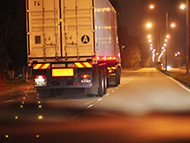Attributed to: GT Lim, General Manager, Safety & Graphics Business Group, 3M Malaysia
Each year, thousands of lives are lost on our roads nationwide without fail, and the numbers continue to rise. According to the Malaysian Institute of Road Safety Research (MIROS), a total of 521,466 road crashes took place in 2016, resulting in a total of 7,152 deaths lost on the road.¹
These statistics are alarming and is most certainly a cause for concern. While you may be aware of common causes that lead to road crashes and fatalities such as reckless driving, ignoring traffic rules or even drunk driving, one of the main factors that play an equally harmful role is low visibility experienced by drivers, especially at night.
Did you know that an estimated 90 per cent of all driver decisions are made based on what they see? Though our eyes are capable of seeing in limited light, the combination of headlights and road lights can cause several problems for your vision.2 While this can be worrisome, the advancement in technology has allowed for comprehensive safety solutions that can help with on-road visibility.
Did you see that road sign?
Among the reasons that contribute to road crashes are the fact that night time drivers lack the visual cues they receive during daylight hours. This includes the visually/optically aimable (VOA) headlights installed in some vehicles which reduces the visibility of signs as much as 53 per cent, depending on the location of the road signs. In addition, the diverse mix of vehicle sizes create various viewing angles between headlights and the driver’s eye level which in turn affects the visibility of signs, particularly for large vehicles. As a result, drivers today face the risk of having their safety compromised as they are getting less luminance from road signs.
To overcome this matter, brighter road signs are required so that drivers are able to read and understand them faster. There’s a distinct correlation between sign brightness and a driver’s ability to comprehend the sign’s message, hence it is important that road signs today use durable micro-prismatic reflective sheeting technology in accordance with government guidelines for optimal performance.
These types of reflective sheeting returns almost 60 per cent of available light and performs at all sight distances, even where signs are positioned in disadvantaged locations. This in turn will require less eyes-off-the-road time, leaving drivers more focused on the task of driving at night. Additionally it is helpful to the aging population as older drivers have slower response times and decreased visual acuity at night.
Guiding you home
One of the basic task for a driver is to follow the road. During daytime driving, this usually isn’t a problem as road visibility is quite high. However, drivers generally face a tougher time when driving at night on dark roads as it is quite difficult to see the direction that the road is taking. It is safe to say that poor road guidance is one of the main problems for night driving.
The ideal way to deal with this situation is to make sure that roads are fitted with highly visible retroreflective pavement markings. Effective pavement markings play a crucial role for safe night time driving as it ensures optimum visibility to motorists, guiding them on the road to stay in their lanes especially during night time driving or in wet conditions. Not only that, the highly refractive microcrystalline ceramic optical elements, a result of technology advancement, enables pavement markings to be more resistant to harsh roadway conditions besides helping to retain visibility in both dry and wet conditions.
Be seen, be safe
More than 6000 people are killed in road accidents in Malaysia every year according to MIROS, and approximately 1000 of these involve passenger car occupants and motorcyclists killed in collision with rigid and articulated type trucks. Based on data from fatal crashes in Malaysia involving heavy commercial good vehicles (HCGV), it was found that the most common types of crash for HCGVs are head-on collisions (33%) and rear impact collisions (28%).3
In read-end crashes, conspicuity plays a significant role, especially at night when visibility is low. It poses even more of a danger when there’s no streetlights, making it difficult for drivers to see the lorries if it’s too dark. To improve heavy vehicle visibility, HCGV and their trailers are now required to be equipped with conspicuity markings and maintained in good condition in order to increase its visibility to others. This will benefit other road drivers who will be aware when these heavy vehicles are stationary in a dark spot, turning or crossing roadways at night, be it in bad weather or low light conditions.
In conclusion, it is critical to improve visibility on the roads to help curb the rising accident and fatality rates in the country. As road safety is at the heart of what we do for the past 75 years, our team has been working closely with the Malaysian government to implement safety features using the latest technology to ensure motorists can arrive at their destionations faster and most importantly, safer.
¹ https://www.miros.gov.my/1/page.php?id=17
² https://seriousaccidents.com/legal-advice/top-causes-of-car-accidents/nighttime-driving/
³ https://www.miros.gov.my/1/publications.php?id_event=492&idxs_page=19&searchPage=84

